Content
All issues / Volume 16 (2022) / Issue 12 (December)
Roland Petrény, László Mészáros
Vol. 16., No.12., Pages 1228-1228, 2022
DOI: 10.3144/expresspolymlett.2022.89
Vol. 16., No.12., Pages 1228-1228, 2022
DOI: 10.3144/expresspolymlett.2022.89
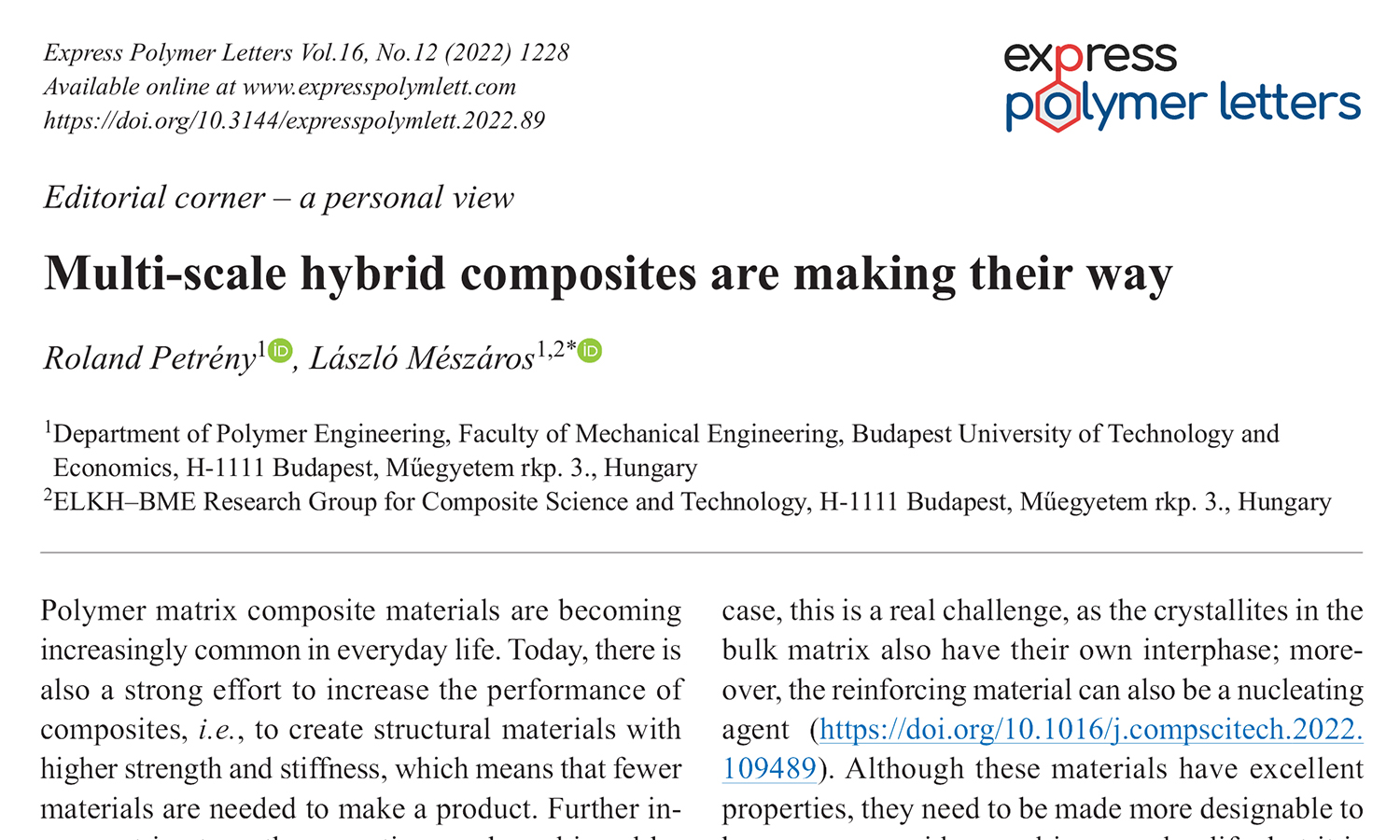
This is an editorial article. It has no abstract.
Pornsiri Toh-ae, Prachid Saramolee, Siriluk Chiarakorn, Dujduan Waraho-Zhmayev, Attapol Kamthong, Raymond Lee Nip, Ekwipoo Kalkornsurapranee, Jobish Johns, Patcharapit Promoppatum, Yeampon Nakaramontri
Vol. 16., No.12., Pages 1229-1252, 2022
DOI: 10.3144/expresspolymlett.2022.90
Vol. 16., No.12., Pages 1229-1252, 2022
DOI: 10.3144/expresspolymlett.2022.90
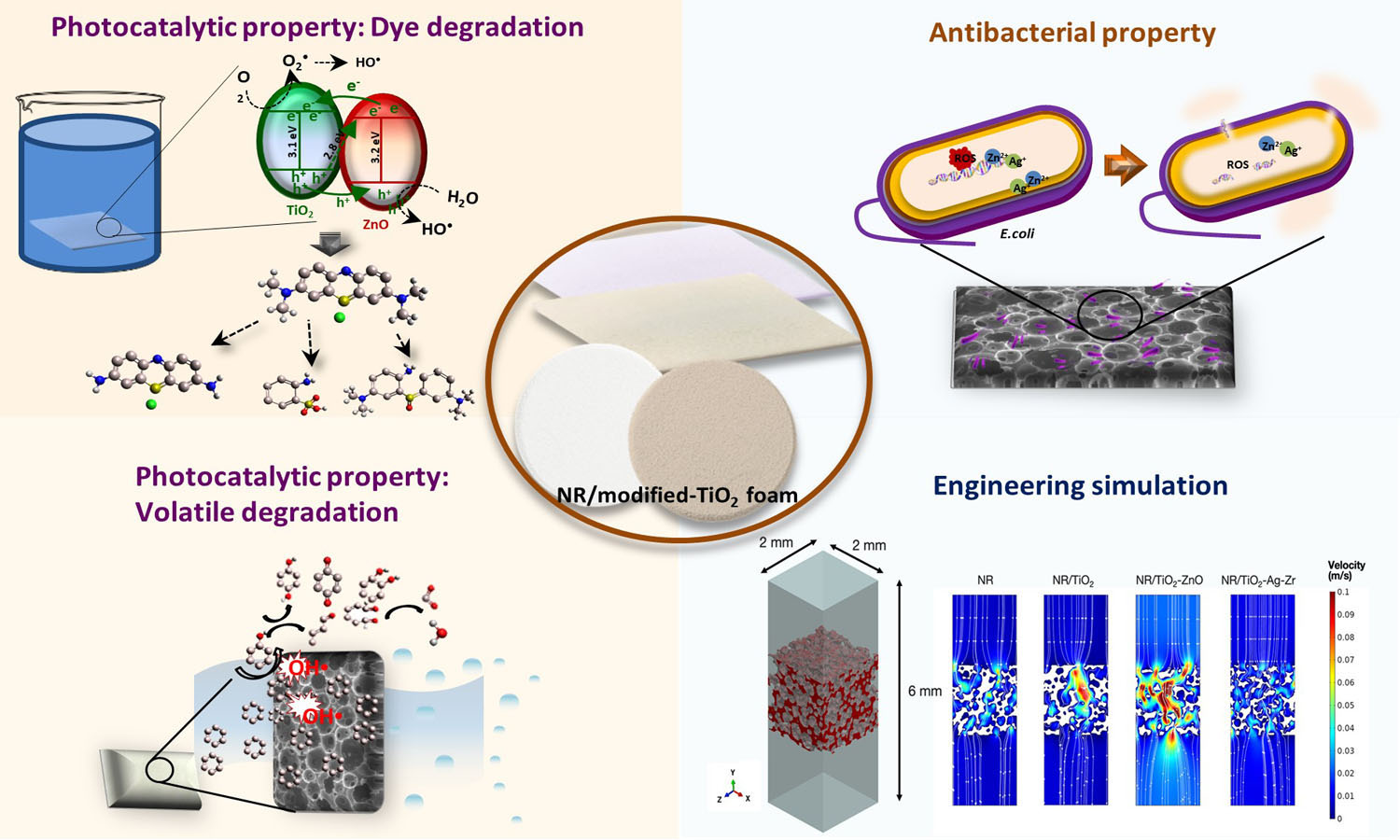
Natural rubber (NR) composite foam was developed through the Dunlop process with better volatile solvent absorption and antibacterial activity. The unmodified and modified titanium dioxide (TiO2), namely TiO2-zinc oxide (TiO2-ZnO) and TiO2-silver doped zirconium (TiO2-Ag-Zr), were incorporated into the foams. The photocatalytic origination under UV and visible light leads the composite foam with TiO2-ZnO to exhibit effective and suitable benzene absorbing and removing abilities. Thus, the specific foam sizes provided the gaseous benzene absorption of 14.0 ppm within 3 h and the gaseous benzene elimination of 7.6 ppm within 14 h in case of the composite with 10 phr TiO2-ZnO. Also, the foams with NR/TiO2-ZnO and NR/TiO2-Ag-Zr exhibited excellent antibacterial activity for E. coli due to the release of Zn+ and ROS species across the rubber foam filter layers to the bacteria surfaces. The resulting composite foam showed superior elastic properties in terms of tensile strength, toughness, and elongation at break. To study the applicability as filter, the engineering simulation relating the air flowability throughout the foam was examined. From the flow velocity and the air permeability of the foam at a specified thickness, it was observed that the NR/TiO2-ZnO exhibited proper porous sizes and shapes for filtrating, reacting, absorbing and removing the gaseous benzene relative to other porous filters.
Somayeh Sharafi Zamir, Babak Fathi, Abdellah Ajji, Mathieu Robert, Said Elkoun
Vol. 16., No.12., Pages 1253-1266, 2022
DOI: 10.3144/expresspolymlett.2022.91
Vol. 16., No.12., Pages 1253-1266, 2022
DOI: 10.3144/expresspolymlett.2022.91
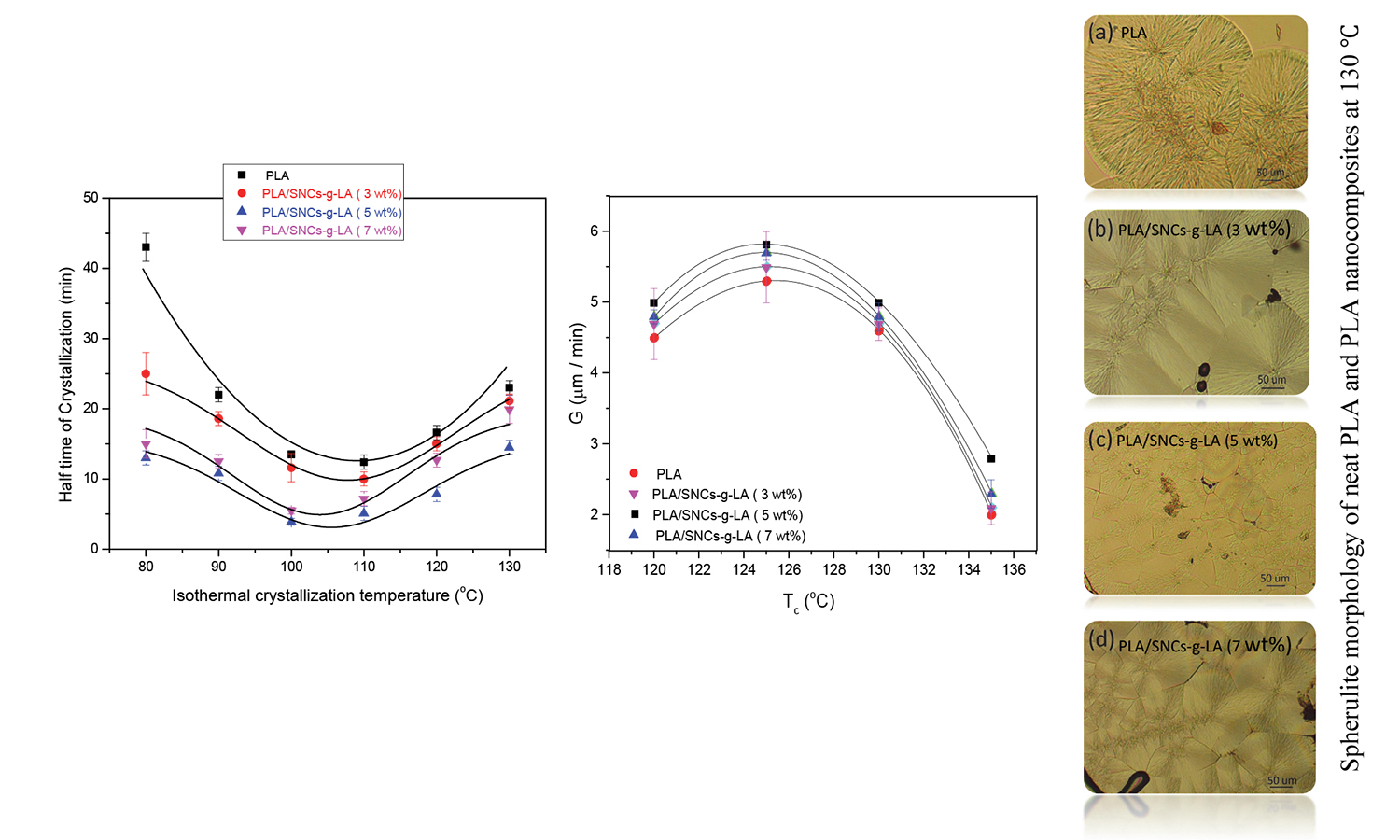
Polylactic acid (PLA) has shown two different crystalline structures, namely α and α′ when cooled down from the melt state. However, α-PLA has shown significant improvement in the barrier and mechanical properties of PLA. Although the effect of some nucleating agents on phase transformation of the PLA has been determined in the past, this is the first attempt, the effect of the starch nanocrystals on the formation of polymorphic crystal structure of PLA was evaluated. In this framework, the effect of lactic acid grafted starch nanocrystals (SNCs-g-LA) concentrations on the phase transition, and crystallization behavior of PLA/SNCs-g-LA nanocomposites at different isothermal crystallization temperatures (Tc) were studied. The results indicate that SNCs-g-LA nanoparticles promote the degree of crystalline transition to yield the highly crystalline ordered α-PLA. Further, the half-time crystallization (t1/2) of PLA composites was calculated by the Avrami equation. The t1/2 of PLA was minimum by adding 5 wt% SNCs-g-LA nanoparticles, and it decreased from 10.4 to 3.9 min. The growth rate of the spherulite morphology of PLA composites showed a significant improvement in the crystalline structure of PLA/SNCs-g-LA (5 wt%) nanocomposites as well. Finally, small angle X-ray scatting (SAXS) analysis showed that the inclusion of 5 wt% grafted SNCs resulted in the increment of the long period (Lac) as well as crystal layer thickness (Lc).
Shakhirul Mat Salleh, Mohd Fadzil Ain, Zulkifli Ahmad, Intan Sorfina Zainal Abidin, Che Muhammad Nor Che Isa
Vol. 16., No.12., Pages 1267-1279, 2022
DOI: 10.3144/expresspolymlett.2022.92
Vol. 16., No.12., Pages 1267-1279, 2022
DOI: 10.3144/expresspolymlett.2022.92
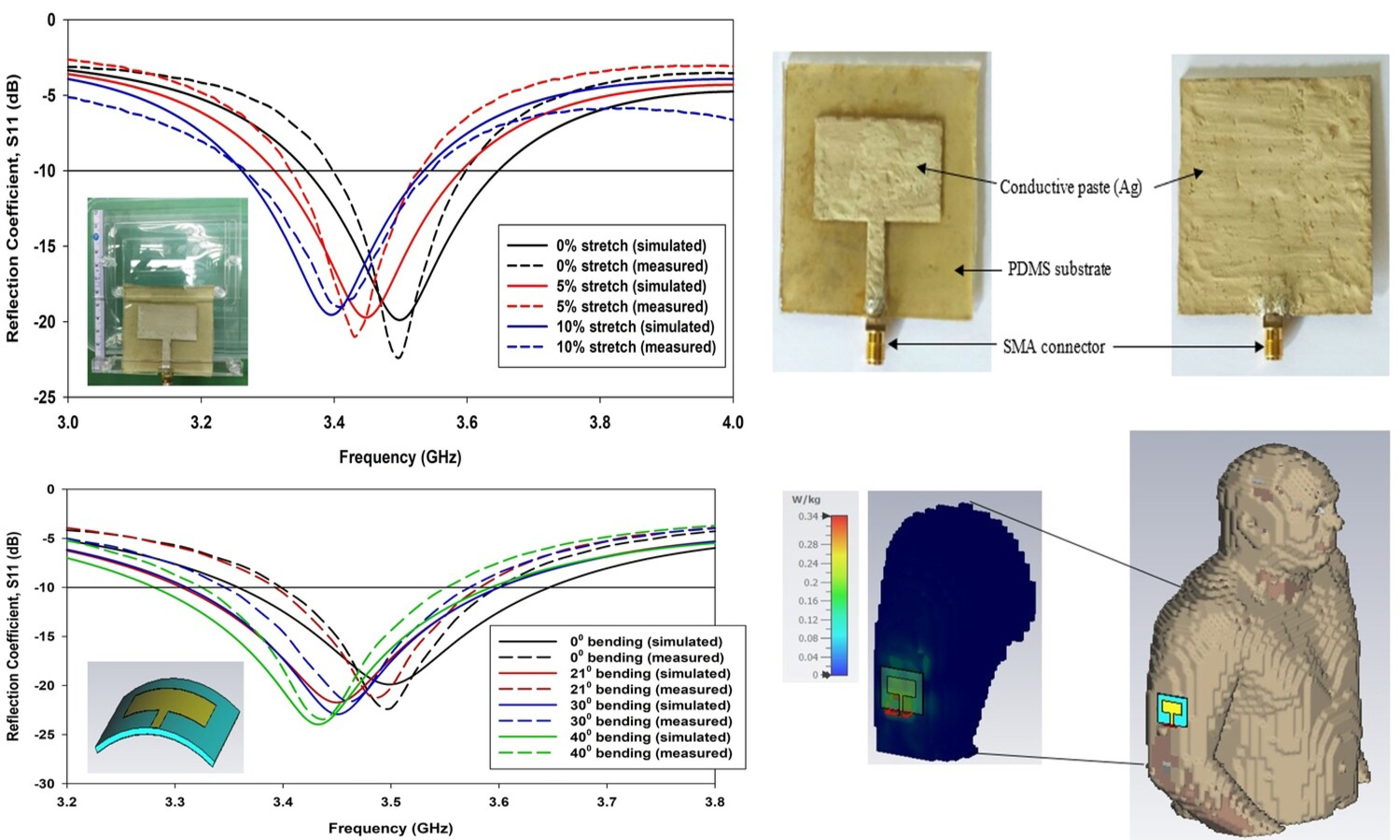
Smart polymer nanocomposite (SPN) is a major interest in the development of wearable electronics, which requires the conductive matrix to be both flexible and stretchable. Polydimethylsiloxane (PDMS) was chosen in this study as it offers flexibility, thermal stability, relative isotropic, homogeneity, low permittivity, and ease of fabrication. The conductive silver paste filler loadings of 40, 50, 60, and 65 wt% were constructed and measured, which showed high conductivity in the range of 1.59–6.58・106 S/m. A rectangular microstrip patch antenna was fabricated based on stretchable PDMS substrate and silver paste polysiloxane composite at a resonance frequency of 3.5 GHz for fifth-generation (5G) communication. The proposed antenna was designed to attach to the human body and integrate with a wearable device. The polymer wearable antenna will easily stretch and bend following the human body shape and movements, which was investigated to further understand the antenna performance at different stretching and bending conditions. Furthermore, the specific absorption rate (SAR) wearable antenna was analysed for safety purposes.
Cesar Troca-Torrado, Maria Alexandre-Franco, Carmen Fernandez-Gonzalez, Manuel Alfaro-Dominguez, Vicente Gomez-Serrano
Vol. 16., No.12., Pages 1280-1303, 2022
DOI: 10.3144/expresspolymlett.2022.93
Vol. 16., No.12., Pages 1280-1303, 2022
DOI: 10.3144/expresspolymlett.2022.93
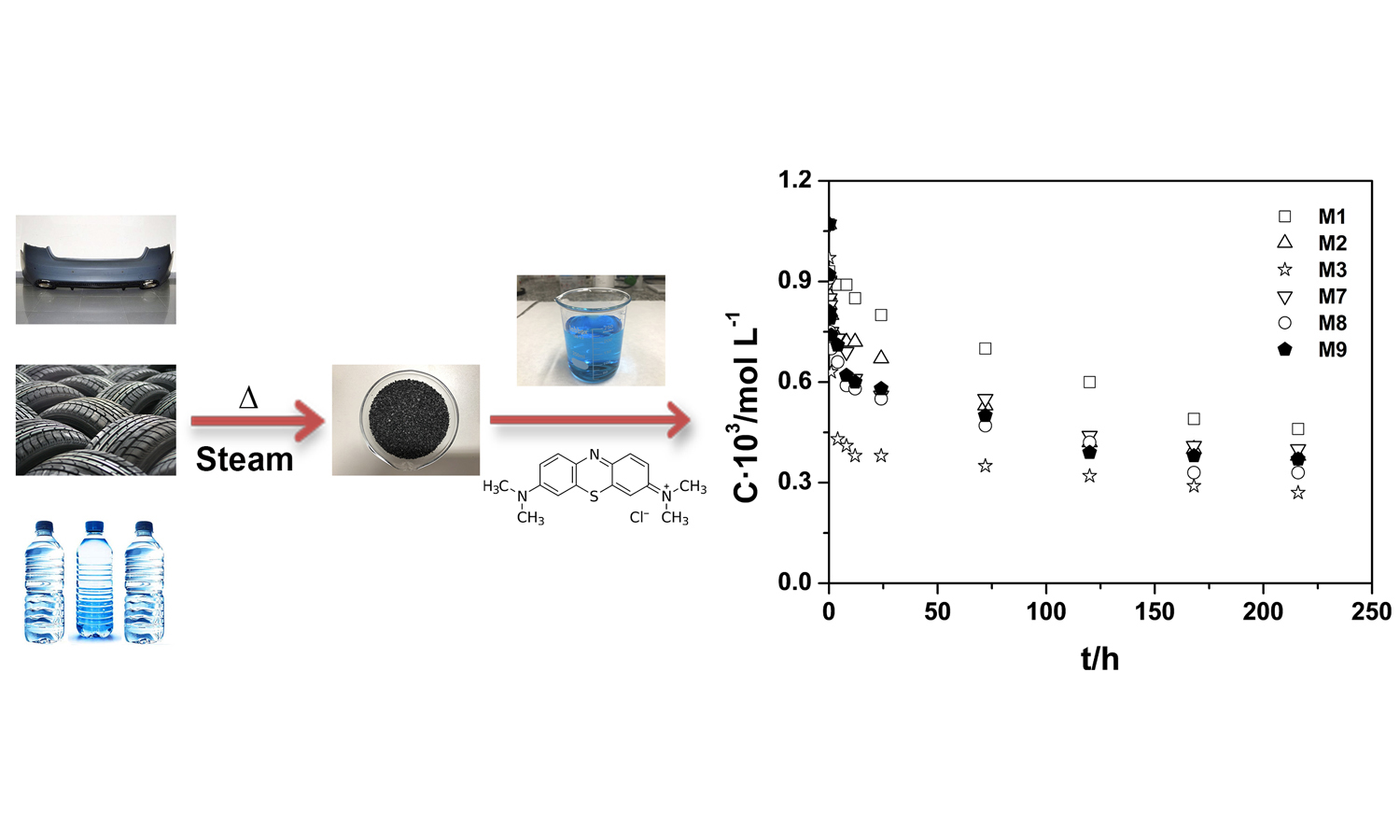
The development of carbonaceous adsorbent (CAs) from rubber of used tires (TR), poly(ethylene terephthalate) plastic bottles (PET) and an industrial PP (plastic)-EPDM (rubber) blend (VR) to be used in water discoloration treatment is studied. Not only the three starting materials separately but also mixtures of two- and three-components at the mass ratios of 50/50 and 75/12.5/12.5 for all of them were used. The CAs were first prepared by heat-treatment of materials at 900°C for 2 h in N2 and at 850°C for 2 h in steam and then characterized by X-ray diffraction (XRD), scanning electron microscopy (SEM), adsorption of N2 at –196°C, mercury porosimetry, FT-IR spectroscopy and measurement of pH of the point of zero charge (pHpzc), and finally tested as adsorbents of methylene blue (MB) in aqueous solution. The yield of the process of preparation of the CAs is significantly higher with TR and quite similar to PET and VR. It noticeably increases or decreases with material mixtures, presumably because of the interaction of VR with TR and PET during such a process. By using such mixtures, larger developments in surface area and porosity are achieved. SBET is 675 m2·g–1 for the sample prepared from the 50/50 mixture of PET and VR (M3), whereas for the products of the separated activation of PET and VR in steam it is 248 and 100 m2·g–1. pHpzc ranges between 5.8 and 11.1. The beneficial effect also concerns the adsorption process of MB. The pseudo-secondorder kinetic constant is 2.69·103 g·mol·h–1 and the Langmuir adsorption capacity is 0.85·103 g·mol·h–1 for M3.
Maximilian Ries, Jakob Seibert, Paul Steinmann, Sebastian Pfaller
Vol. 16., No.12., Pages 1304-1321, 2022
DOI: 10.3144/expresspolymlett.2022.94
Vol. 16., No.12., Pages 1304-1321, 2022
DOI: 10.3144/expresspolymlett.2022.94

The addition of nano-sized filler particles enhances the mechanical performance of polymers. The resulting properties of the polymer nanocomposite depend on a complex interplay of influence factors such as material pairing, filler size, and content, as well as filler-matrix adhesion. As a complement to experimental studies, numerical methods, such as molecular dynamics (MD), facilitate an isolated examination of the individual factors in order to understand their interaction better. However, particle-based simulations are, in general, computationally very expensive, rendering a thorough investigation of nanocomposites’ mechanical behavior both expensive and time-consuming. Therefore, this paper presents a fast coarsegrained MD model for a generic nanoparticle-reinforced thermoplastic. First, we examine the matrix and filler phase individually, which exhibit isotropic elasto-viscoplastic and anisotropic elastic behavior, respectively. Based on this, we demonstrate that the effect of filler size, filler content, and filler-matrix adhesion on the stiffness and strength of the nanocomposite corresponds very well with experimental findings in the literature. Consequently, the presented computationally efficient MD model enables the analysis of a generic polymer nanocomposite. In addition to the obtained insights into mechanical behavior, the material characterization provides the basis for a future continuum mechanical description, which bridges the gap to the engineering scale.
Zhen Yu, Leyuan Ma, Bojiang Zhu, Ajit Dattatray Dattatray Phule, Shibao Wen, Yongxian Zhao, Zhenxiu Zhang
Vol. 16., No.12., Pages 1322-1330, 2022
DOI: 10.3144/expresspolymlett.2022.95
Vol. 16., No.12., Pages 1322-1330, 2022
DOI: 10.3144/expresspolymlett.2022.95
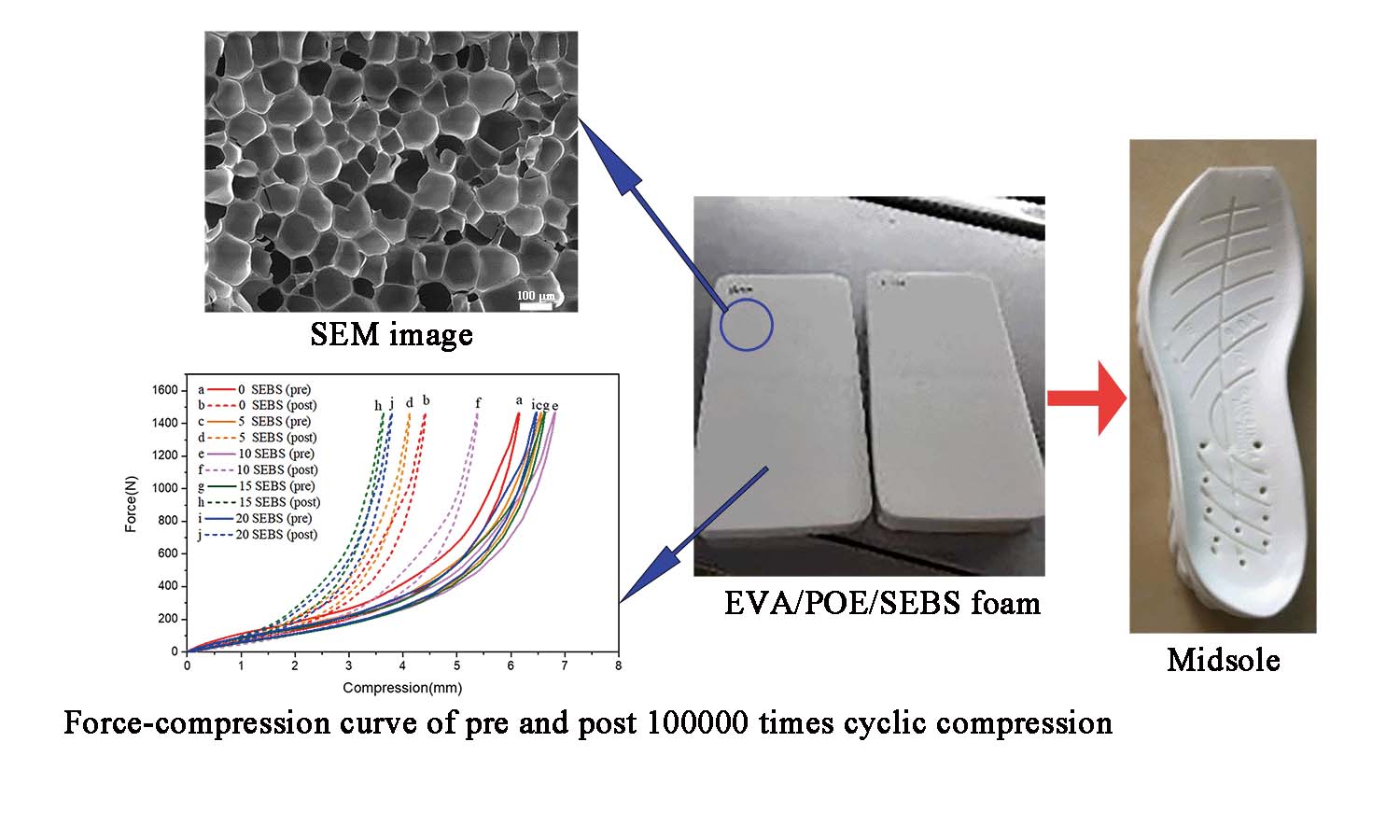
Thermoplastic elastomer foam is often used as a midsole, which is an important factor affecting sports efficiency. In this research, ethylene vinyl acetate copolymer/polyolefin elastomer/styrene ethylene butylene styrene (EVA/POE/SEBS) microcellular foam was prepared with supercritical nitrogen gas (SC-N2). The influence of the formulation ratio on the matrix network structure was studied by vulcanization curve and rheometric expansion system rheometer. Then the foaming behavior and static/dynamic mechanical properties were studied, and midsole was prepared. The results showed that the increase of the relative content of SEBS reduced the viscosity of the matrix, but the loss factor increased, which further reduced the resistance to cell growth and increased the expansion ratio (density decreased from 0.19 to 0.13 g/cm3). In addition, the increase of SEBS resulted in an increase in the static compressive strength and resilience (61%) of the foam. However, after 100 000 dynamic compression cycles, the increase of SEBS resulted in a decrease in the energy absorption capacity of the foam and an increase in the dynamic compression set (from 6.8 to 9.4%). This is significantly different from the traditional physical and mechanical performance test results, which are rarely reported and have significance for practical applications.
Nicolas Candau, Eduard Vives, Ana Ines Fernandez, Oguzhan Oguz, Guillaume Corvec, Carlos Eloy Federico, Joao Paulo Cosas Fernandes, Gregory Stoclet, Maria Lluisa Maspoch
Vol. 16., No.12., Pages 1331-1347, 2022
DOI: 10.3144/expresspolymlett.2022.96
Vol. 16., No.12., Pages 1331-1347, 2022
DOI: 10.3144/expresspolymlett.2022.96
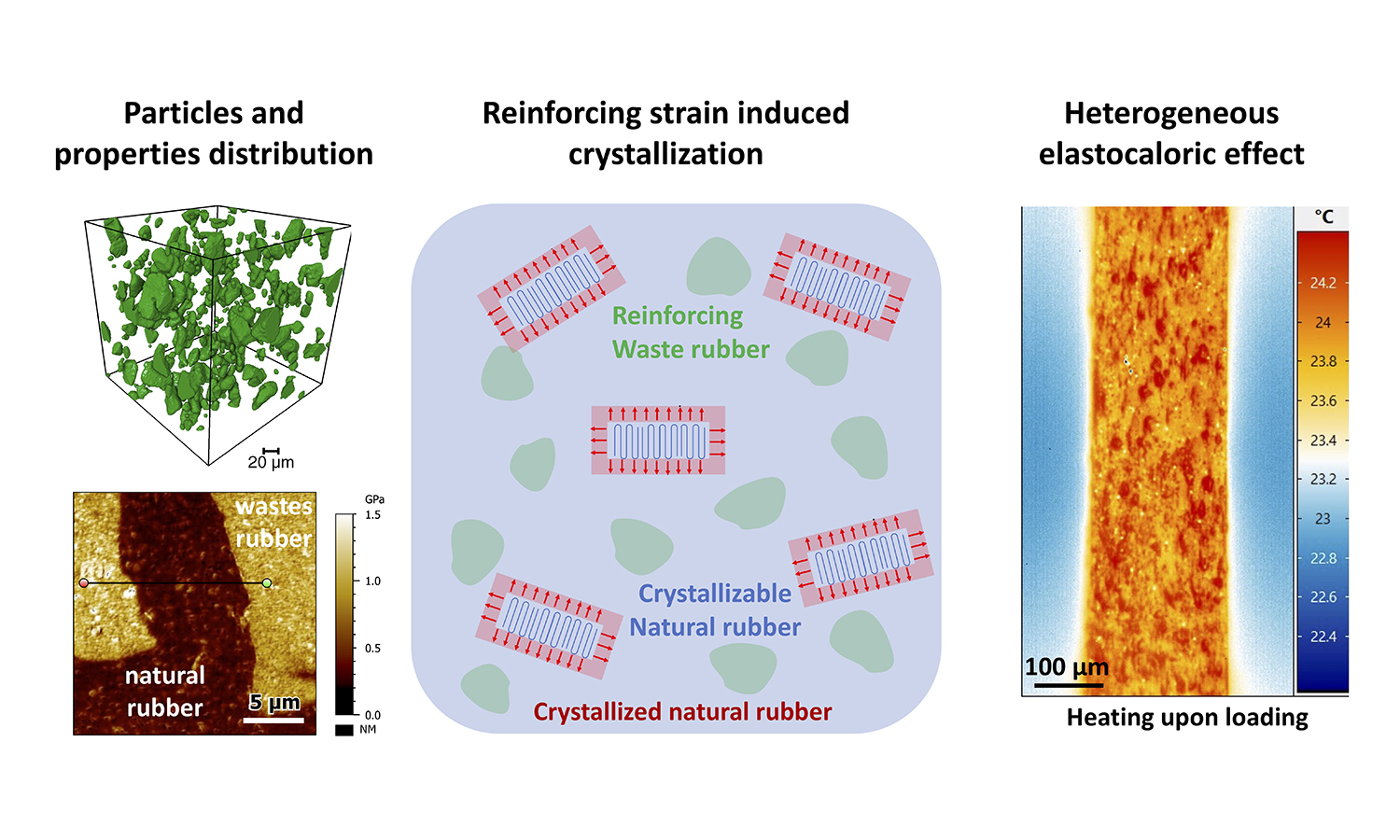
The strain-induced crystallization and elastocaloric properties of various natural rubber (NR)/ground tire rubber (GTR) blends, comprising waste particles of diverse sizes and contents, were investigated. The decreasing inter-distance between particles in conjunction with their increasing content as studied by micro-computed tomography (μCT) as well as the inter-melling between GTR and NR matrix were observed. It resulted in a strain localization in the NR matrix at the GTR and NR interface at the origin of mechanical reinforcement upon tensile deformation. In addition, GTR particles were found to show a nucleating ability on strain-induced crystallization (SIC) and elastocaloric properties independently of the particle size. The strain localization was found to relate to a localization of the temperature field, suggesting localization of the elastocaloric effect in NR/GTR blends. The evidence of such heterogeneities would be of interest for the proper design of elastocaloric waste-based rubber composites for heating/cooling applications.


